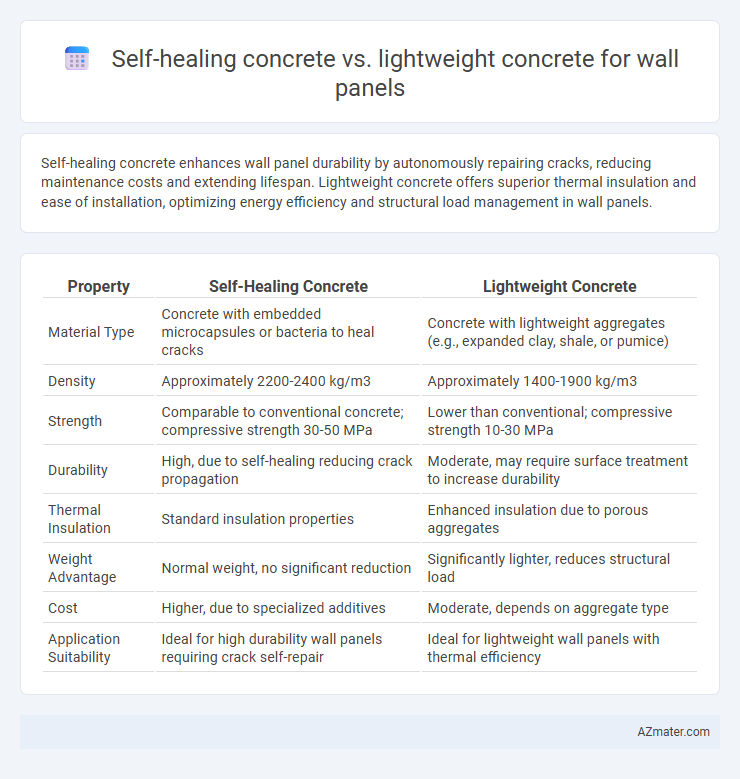Self-healing concrete enhances wall panel durability by autonomously repairing cracks, reducing maintenance costs and extending lifespan. Lightweight concrete offers superior thermal insulation and ease of installation, optimizing energy efficiency and structural load management in wall panels.
Table of Comparison
| Property | Self-Healing Concrete | Lightweight Concrete |
|---|---|---|
| Material Type | Concrete with embedded microcapsules or bacteria to heal cracks | Concrete with lightweight aggregates (e.g., expanded clay, shale, or pumice) |
| Density | Approximately 2200-2400 kg/m3 | Approximately 1400-1900 kg/m3 |
| Strength | Comparable to conventional concrete; compressive strength 30-50 MPa | Lower than conventional; compressive strength 10-30 MPa |
| Durability | High, due to self-healing reducing crack propagation | Moderate, may require surface treatment to increase durability |
| Thermal Insulation | Standard insulation properties | Enhanced insulation due to porous aggregates |
| Weight Advantage | Normal weight, no significant reduction | Significantly lighter, reduces structural load |
| Cost | Higher, due to specialized additives | Moderate, depends on aggregate type |
| Application Suitability | Ideal for high durability wall panels requiring crack self-repair | Ideal for lightweight wall panels with thermal efficiency |
Introduction: Self-Healing Concrete vs Lightweight Concrete for Wall Panels
Self-healing concrete incorporates microcapsules or bacteria that autonomously repair cracks, enhancing durability and reducing maintenance for wall panels. Lightweight concrete offers reduced density by incorporating aggregates like expanded clay, improving thermal insulation and ease of handling while maintaining structural integrity. Both materials present innovative solutions for wall panel construction, balancing strength, longevity, and energy efficiency.
Material Composition and Technology Differences
Self-healing concrete incorporates microcapsules or bacteria that activate upon cracking, enabling autonomous repair through calcium carbonate precipitation, while lightweight concrete utilizes aggregates like expanded clay, pumice, or recycled materials to reduce density and enhance thermal insulation. The core technology of self-healing concrete centers on bio-based or chemical agents embedded within traditional cementitious material, contrasting with lightweight concrete's focus on aggregate modification to achieve structural efficiency and weight reduction. Material composition differences directly influence performance in wall panels, where self-healing concrete enhances durability and lifespan through crack repair, and lightweight concrete optimizes load-bearing capacity and energy efficiency.
Structural Performance and Load-Bearing Capacity
Self-healing concrete enhances structural performance by autonomously repairing cracks, thereby improving long-term durability and load-bearing capacity in wall panels. Lightweight concrete offers reduced density, leading to easier handling and lower dead loads, but typically provides lower compressive strength compared to traditional and self-healing variants. Balancing the structural benefits of crack resistance in self-healing concrete with the weight advantages of lightweight concrete is critical for optimizing wall panel performance in load-bearing applications.
Durability and Longevity in Wall Applications
Self-healing concrete enhances wall panel durability by autonomously repairing microcracks, significantly extending structural lifespan and reducing maintenance costs. Lightweight concrete, while offering reduced weight and thermal insulation, may have lower compressive strength and increased susceptibility to cracking, potentially compromising long-term durability in wall applications. For walls requiring superior longevity and resilience, self-healing concrete provides a more robust solution due to its intrinsic crack-sealing properties and enhanced moisture resistance.
Crack Resistance and Maintenance Requirements
Self-healing concrete exhibits superior crack resistance by autonomously repairing micro-cracks through embedded healing agents, significantly reducing maintenance needs for wall panels. Lightweight concrete, while offering benefits in weight reduction and thermal insulation, tends to have lower crack resistance and may require more frequent repairs or maintenance interventions. Choosing self-healing concrete enhances durability and long-term performance of wall panels, minimizing lifecycle costs associated with crack-related damage.
Thermal Insulation and Energy Efficiency
Self-healing concrete enhances wall panel durability by automatically sealing cracks, reducing maintenance costs and improving long-term energy efficiency through minimized air leakage. Lightweight concrete offers superior thermal insulation due to its low density and high porosity, significantly lowering heat transfer and reducing heating and cooling demands. Combining self-healing properties with lightweight material can optimize wall panel performance, balancing energy efficiency with structural longevity.
Environmental Impact and Sustainability
Self-healing concrete reduces maintenance and extends structural lifespan by autonomously repairing cracks, significantly lowering the environmental impact through decreased resource consumption and waste production. Lightweight concrete offers improved thermal insulation and reduced material use, enhancing energy efficiency and lowering carbon emissions in wall panels. Both materials contribute to sustainable construction, with self-healing concrete prioritizing durability and maintenance reduction, while lightweight concrete emphasizes energy savings and resource efficiency.
Cost Comparison and Economic Feasibility
Self-healing concrete for wall panels typically incurs higher initial costs due to advanced materials and technology integration but offers long-term savings by reducing maintenance and repair expenses. Lightweight concrete presents lower upfront costs and ease of installation, benefiting projects with tight budget constraints and faster timelines. Evaluating economic feasibility requires balancing immediate expenditure against lifecycle cost savings, where self-healing concrete is optimal for durability-focused applications and lightweight concrete suits cost-sensitive, non-structural walls.
Installation Process and Construction Challenges
Self-healing concrete wall panels simplify installation by reducing the need for frequent repairs, thereby minimizing downtime and labor costs during construction. Lightweight concrete panels offer ease of handling and faster installation due to their reduced weight but may require more precise curing and support to prevent cracking. Both materials present challenges: self-healing concrete demands specialized additives that can affect mixing consistency, while lightweight concrete requires careful quality control to maintain strength and thermal performance.
Best Use Cases and Application Scenarios
Self-healing concrete excels in infrastructure and building walls requiring enhanced durability and crack resistance, ideal for long-term structural integrity in harsh environments such as bridges, tunnels, and high-moisture areas. Lightweight concrete offers superior thermal insulation and reduced structural load, making it best suited for residential wall panels, high-rise buildings, and projects emphasizing energy efficiency and ease of installation. Selecting between the two depends on project priorities: self-healing concrete for sustainability and maintenance cost reduction, and lightweight concrete for improved thermal performance and weight-sensitive constructions.

Infographic: Self-healing concrete vs Lightweight concrete for Wall panel
 azmater.com
azmater.com